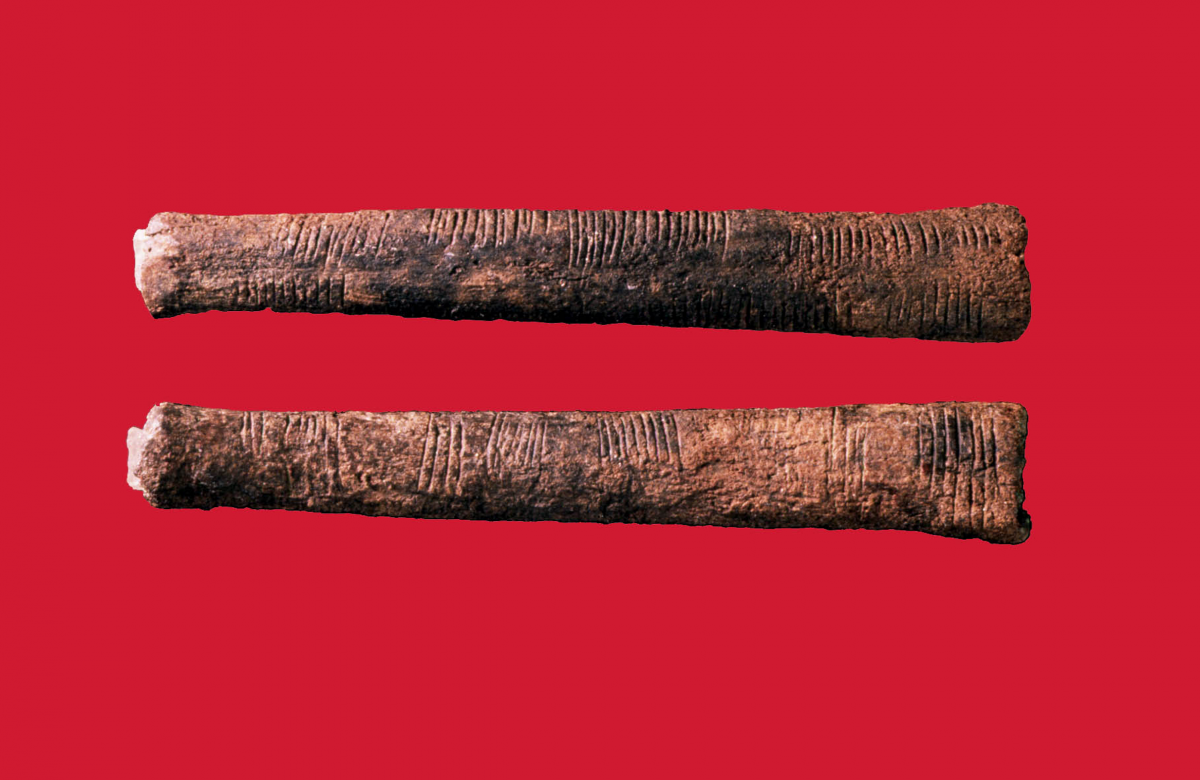The early history of mathematics has always excited me. Discovering how people from the Antiquity did mathematics is incredibly interesting and satisfying. In the past months, I have done some research on this topic, especially old manuscripts. Therefore in this post I want to share my discoveries with you all.
Ishango Bone
In 1960, a Belgian geologist discovered an interesting baboon bone with some strange markings on it. At first people though that they were just some tally sticks used by an ancient African Tribe. It turned up that this is not the case. Researchers discovered that there is more behind those marks than just some “counting” methods.

It has been discovered that there is some sign of doubling, halving, odd numbers, primes and multiples of 12. The way they realised that there is some doubling, halving related to the number of notches from specific columns: 3 notches that are followed by 6 notches; 4 notches followed by 8 notches; 10 notches followed by 5 notches. Also, it looks like on one column there are all the prime numbers between 10 and 20: 11, 13, 17 and 19. Another interesting aspect is the fact that the numbers on each column add up to 60 or 48 (multiples of 12). For example, the row with prime numbers – they add up to 60: 11 + 13 + 17 + 19 =60. Some people believe that they also knew the difference between even and odd numbers (on one column there are just odd numbers, but not all the numbers from that range: the only numbers are 9, 11, 13, 17, 19, 21. There are still things they are researching about these notches.
Quipu
Quipus are “databases” or “memory banks” made from strings and knots for storing numbers – kind of like the first statistical data collection for numbers. There have been discovered some quipus from 5,000 years ago in Caral, Peru. The way the Incas created these records is incredibly interesting. Everything from the position and type of the knots, the direction of the cord, the color and spacing represents a number attributed to some specif activity or object.

Researchers believe that the quipus may contain information about construction plans, dance moves and even history. It is so interesting to see how civilizations have developed logical, numerical and mathematical thinking before developing writing. For Incas, it was more important to understand these number patterns and recording them, than writing.
Book Recommendation if you want to find out more about quipu and the mathematics of the Inca civilization: “Mathematics of the Incas Code of the Quipu” by Marcia Ascher and Robert Ascher. Enhanced with over 125 illustrations, this unusual and thought-provoking study will interest mathematicians, historians, anthropologists, archeologists, and students of folk art with its unique perspective on the way in which pieces of colored string serve to embody a rich, logical, numerical tradition and are, ultimately, a metaphor for the civilization that created them. Preface. Exercises and answers within chapters.

Plimpton 322
On the same historical vibe, we have a very interesting Babylonian clay tablet. Eleanor Robson said that this is “one of the world’s most famous mathematical artifacts”. I was so surprised to find out that this tablet from around 1800 BC lists Pythagorean triples. If in any case you forgot, Pythagorean triples are numbers that satisfy the Pythagoras theorem – a² = b² + c². Up to this day, researchers still do not know the precise meaning of all the numbers on the tablet. Some think they are just list of specific numbers, others think they are solutions for students studying algebra or trigonometry problems.

A little funny is the fact that this tablet is named after publisher George Plimpton, who bought this tablet for $10 from a dealer in 1922 (that is an incredibly good deal for such a significant old artifact). He then donated it to Columbia University.
Rhind Papyrus
This is one the most important pieces of information concerning the mathematics of ancient Egyptians. Also, it contains one of the earliest-known symbol for a mathematical operation – plus. Don’t think about our modern day “+”, they represented plus as a pair of legs walking towards the number to be added – quite ingenious, like the number is walking towards the other number to become one bigger number. The scroll covers a multitude of topics; here are just a couple: fractions, arithmetic progressions, algebra (my favorite – curious how people where doing algebra then without all the modern symbols we have now), pyramid geometry (very obvious – it’s Egyptian after all), accounting and many more.

As Plimpton 322, this is another example of a random buy from a market. This time we have a Scottish lawyer, Alexander Henry Rhind, who bought the scroll from a market in Luxor. Not sure if he got such a good deal as the 10$ Plimpton got, but anyway.
Hope you enjoyed this more historical post. Which one is your favorite? If you have ideas for future blog posts, let us know. Don’t forget to check our last post: Day 6 | Studying Logic. You can find us on Facebook, Tumblr, Google+, Twitter and Instagram. We will try to post there as often as possible. Enjoy the day!
Lots of love and don’t forget that maths is everywhere! Enjoy!


Leave a comment